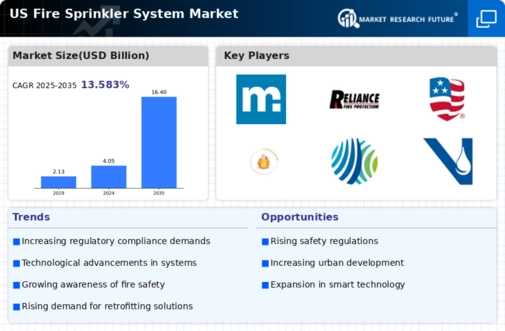Increased Awareness of Fire Safety
The growing awareness of fire safety among businesses and homeowners is a crucial driver for the fire sprinkler-system market. As incidents of fire-related disasters continue to be reported, the demand for effective fire protection systems has surged. This heightened awareness is reflected in the increasing number of fire safety training programs and public campaigns aimed at educating individuals about the importance of fire prevention. Consequently, the fire sprinkler-system market is experiencing a notable uptick in demand, with projections indicating a growth rate of approximately 7% annually. This trend suggests that as more people recognize the value of fire safety measures, investments in fire sprinkler systems are likely to rise, further propelling the market forward.
Insurance Incentives for Fire Safety
Insurance companies are increasingly offering incentives for businesses and homeowners to install fire sprinkler systems, which serves as a significant driver for the fire sprinkler-system market. By providing premium discounts for properties equipped with these systems, insurers encourage the adoption of fire safety measures. This trend not only reduces the risk of fire-related losses but also promotes the installation of fire sprinkler systems as a cost-effective solution. As a result, the fire sprinkler-system market is likely to benefit from this shift in insurance practices, with an estimated increase in installations by 10% over the next few years. This dynamic indicates a growing recognition of the financial advantages associated with enhanced fire protection.
Construction Boom in Commercial Sector
The ongoing construction boom in the commercial sector significantly impacts the fire sprinkler-system market. With the rise in new commercial buildings, including offices, retail spaces, and warehouses, there is an increasing requirement for fire protection systems. According to recent data, the commercial construction sector in the US is expected to reach a value of $1 trillion by 2026, which will likely drive the demand for fire sprinkler systems. Building codes and regulations often mandate the installation of these systems in new constructions, further solidifying their necessity. As a result, the fire sprinkler-system market is poised for substantial growth, driven by the expansion of commercial infrastructure.
Government Mandates and Building Codes
Government mandates and building codes play a critical role in shaping the fire sprinkler-system market. Various states have implemented stringent regulations requiring the installation of fire sprinkler systems in residential and commercial buildings. These mandates are designed to enhance public safety and reduce the incidence of fire-related casualties. As a result, compliance with these regulations is driving the demand for fire sprinkler systems. Recent legislative changes indicate that more jurisdictions are likely to adopt similar requirements, potentially increasing the market size by 15% over the next five years. This regulatory environment underscores the importance of fire sprinkler systems in safeguarding lives and property.
Technological Integration in Fire Safety
The integration of advanced technologies into fire safety systems is emerging as a pivotal driver for the fire sprinkler system market. Innovations such as smart sprinkler systems, which utilize IoT technology for real-time monitoring and control, are gaining traction. These systems not only enhance the effectiveness of fire suppression but also provide valuable data for maintenance and risk assessment. The market for smart fire safety solutions is projected to grow at a CAGR of 8% through 2028, indicating a strong shift towards technologically advanced fire sprinkler systems. This trend suggests that as technology continues to evolve, the fire sprinkler-system market will likely adapt, leading to improved safety outcomes and increased consumer interest.






















Leave a Comment